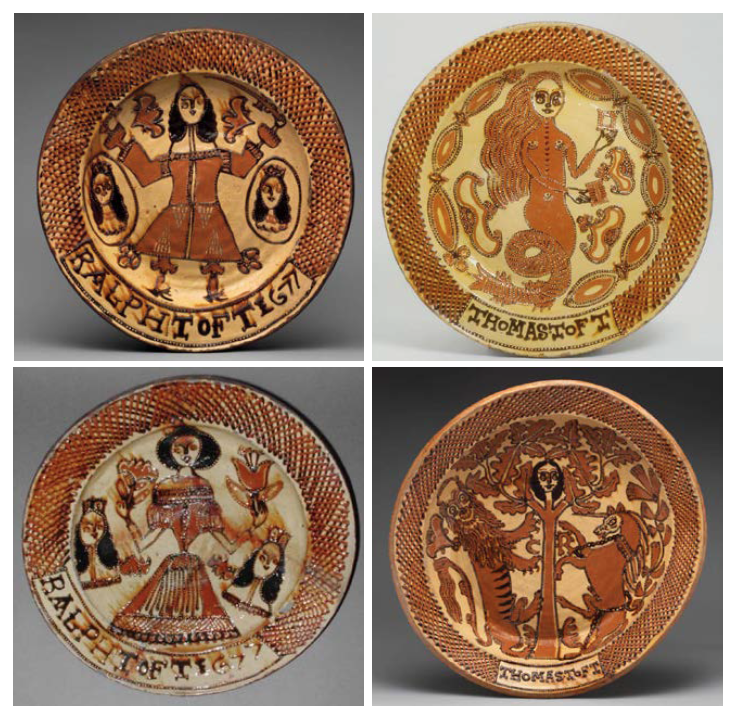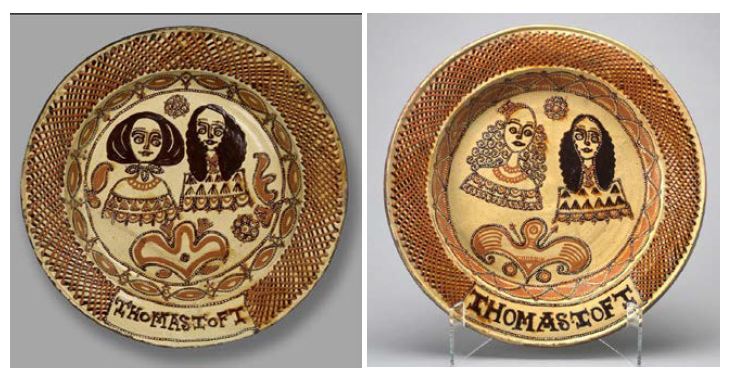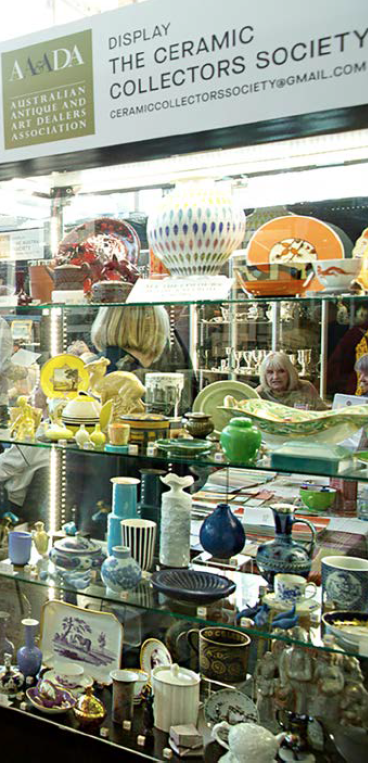Article
TOFT WARE
CERAMIC COLLECTORS SOCIETY
English brothers Thomas Toft and Ralph Toft were early exponents of the English slipware-style, so much so that the practice is sometimes referred to as “Toft ware” regardless of who produced the piece.
Thomas and Ralph Toft created large slipware plates, dishes and platters, boldly decorated with trailed-slip decoration, and are now highly prized pieces held in several museums around the world.
Thomas, whose work is most prevalent to see in museum collections today, potted in Staffordshire, England, in the mid- to late-1600s. He would first coat the earthenware clay-shape with a uniform coat of ‘slip’, which is essentially clay mixed with water, to form a smooth, even foundation for his decoration. Toft then used “trailings” of liquid clay of a different colour on top of the slip foundation to decorate the piece.
Ralph is believed to be Thomas’ brother, but some researchers say he could have been Thomas’ son as the latter worked much later. Whatever the case, Ralph employed a similar technique and decorative style to create his slipware pottery.
Here are four examples of “Toft Ware” plates from various museums, all potted in the 17th-century in Staffordshire. Can you tell which Toft made what, the giveaway is clear to see. Because of the good preservation of these plates and dishes, most scholars now believe they were used primarily as decorative pieces rather than as cooking or dining-ware.

1. Plate by Ralph Toft, Metropolitan Museum of Art, New York.
2. “ The Mermaid Dish,” by Thomas Toft, Victoria & Albert Museum, East Kensington, London.
3. Plate by Thomas Toft, Metropolitan Museum of Art, New York.
4. D ish by Ralph Toft, The Fitzwilliam Museum, Cambridge, England.
THE ROYAL COUPLE
Two slip-ware dishes made by Thomas Toft of Staffordshire in the late 1600s to honour two different Royal couples of England.
This large dish on the left is a ‘charger’ and was made as a display piece to celebrate a marriage. Though the couple depicted are not identified by any inscription, it is likely that they represent King Charles II of England and his 24-year-old bride, Catherine of Braganza, daughter of the king of Portugal. They were married in 1662, two years after the monarchy of England had been restored following the Cromwellian interregnum, and it is likely that dishes like this were made specifically for display in the houses of Royalists.

6. Ashmolean Museum, Oxford University
The second plate is a later 43cm-diameter dish, circa 1670s, and features the Duke of York, later to be James II of England, and his bride Anne Hyde. They are placed above a formalised lily. On the rim there is a trellis pattern, as well as the potter’s signature, ‘Thomas Toft’. Both dishes are made of Staffordshire slip-decorated earthenware. Works like these were being produced in the decades just before factory methods were introduced into the pottery industry.
Toft was the exemplar of slip-ware earthenware plates made in England during this period.
There is nothing new about Royal commemorative wares!
Credit: The Ashmolean Museum Oxford and the Fitzwilliam Museum Cambridge.
THE CERAMIC COLLECTORS SOCIETY
The Ceramic Collectors Society was founded on the 13th of September 1949, by a small group of antique dealers and ceramic collectors in Sydney. Its aim is to promote appreciation and knowledge of ceramic art and to form a meeting ground for all those interested in ceramics.
The Society has staged a number of exhibitions: “Chinese Pottery and Porcelain” (1951), “Chelsea and Chelsea-Derby” (1952), “18th Century Worcester” (1953), “Continental Porcelain” (1954), “Old English China” (1959), “Worcester Porcelain” (1978), “Chelsea, Derby and Bow” (1979), “Oriental Ceramics and their Influence on Europe” (1982), “Pottery Through the Ages” (1985), “Fired with Enthusiasm: Celebrating Ceramic Diversity” (1999), and “Fragile Treasures (2009).

We hold regular meetings of members for illustrated lectures and discussions, frequently accompanied with relevant ceramic and decorative pieces from the collections of presenters and members, to view and enjoy. Presenters are drawn from within the Society’s membership and from local, national and international experts. The Society has also organised seminars and workshops with visiting experts; in recent years they have been on French porcelain, 18th and 19th century English ceramics, and 20th century ceramics. Occasionally, visits are organised to places of interest such as exhibitions and collections. This Newsletter is issued six times a year. The Society normally meets on fourth Monday of every second month.
Recently the society delivered a study-day on the subject of ‘Dutch Delft’ at a Heritage House in Glebe, Sydney. The event focused on the Chinoise aesthetic of Dutch Delft. Members later displayed Delft pieces from their own collections. A lavish lunch and afternoon tea ended the day.
The Ceramic Collectors Society was one of several decorative arts groups at the Australian Antique & Art Dealers Association fair at the White Bay Cruise Terminal in Sydney. A members’ information stand operated during the four-day fair and attracted several new members.
Our stand included a display case of items from the private collections of our committee members. The theme was “All the colours of the rainbow and more”.
Ceramic Collectors Society
PO Box 1, Darlinghurst, NSW 1300
ceramiccollectorssociety@gmail.com
AAADA Antiques & Art Fair Sydney
1-3 September 2023
The Great Hall – University of Sydney
aaada.org.au/sydney
Tickets on sale now SYDNEY
Buy your tickets online for a chance to WIN $1,000 to spend at the AAADA Antiques & Art Fair Sydney and a AAADA representative will take you around the fair providing you with guidance as you browse. All admission tickets purchased to either fair online are automatically entered for their corresponding location. For eligibility check our T&Cs on our website. Entries for Sydney close 5pm on the 29th of August 2023 (AEST).
AAADA 2023 ANTIQUES & ART FAIR MELBOURNE CATALOGUE OUT NOW
CLICK HERE
Click for a full list of our dealers, service providers & Decorative Arts & Collectors Societies
Australian Antique & Art Dealers Association
info@aaada.org.au
+61 498 059 661
Facebook
Instagram